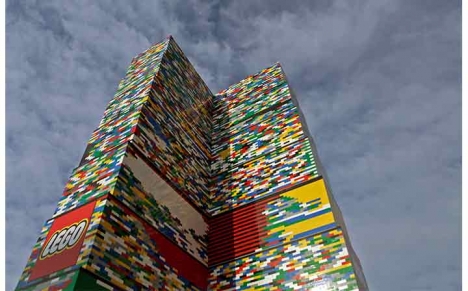Biggest decorated cake

Photo: Carla Bergamini
In May, 300 Italian bakers got together in Milan to make the world’s biggest decorated cake, which measured 16.46 metres by 13.94 metres and weighed over a tonne. It was decorated with a map of Italy, including edible sugar sculptures of its best known monuments such as the Leaning Tower of Pisa and the Colosseum.
Longest pizza…twice

Photo: Olivier Morin/AFP
Pizza chefs and volunteers toiled for 16 hours in Rende in Calabria to produce a 1.229 kilometre pizza, smashing a record previously set by Spain. No doubt the team was delighted to bring the title back to the homeland of pizza, but the main motivation of the project was to raise money for a shuttle bus to help the town’s disabled and elderly residents get around. However, they only held their crown for a few days, before an enormous 1,595.45 metre-long margherita pizza at the Milan Expo broke the newly-set record.
Longest baguette
A 400-foot-long baguette smeared with Nutella breaks the Guinnes Record at Milan Expo http://t.co/ZHZvXQS904 pic.twitter.com/qfDLWrGIR0
— L'Italo-Americano (@Italo_Americano) October 18, 2015
In fact, the Milan Expo was the scene of several record-breaking bakes. Sixty French and Italian chefs put national rivalries aside to work on the longest ever baguette, which when finished measured 120 metres. What did they fill the bread with? Nutella, of course.
Largest tiramisu

Photo: Gemona Turismo
A giant tiramisu was whipped up in the northern town of Gemona by a team of 300, with 30 pastry chefs on hand to ensure the recipe was followed correctly. A crane had to be used to weigh the 3,015 kilo dessert, which was created as part of a competition between local businesses.
Tallest lego tower

Photo: Lego
Supersized foods may have taken centre stage this year, but Italy was also the setting for the construction of the world’s tallest ever lego tower. Over five days, a team of 18,000 volunteers painstakingly worked on the 35.05 metre high tower using over half a million of the small coloured bricks. But it was more than just an impressive feat of construction – a spokesperson for Lego said the company would donate almost €25,000 to an urban development project in honour of the tower.
Oldest ever Italian

Photo: Youtube screengrab
One of the most impressive record-holders on this list, Emma Morano became the longest living Italian in history in November. As she celebrated her 116th birthday, she had two tips to offer to anyone hoping to match her longevity: eat lots of eggs, and stay single.
Fastest skier

Photo: Gerard Julien/AFP
Moving on to the world of sport, Italian skier Simon Origone broke the record for speed skiing back in April. He reached 252.632km per hour (156.978mph), beating the previous world record – which had also been set by him.
Most consecutive headspins
In December, professional breakdancer Stefano Maso smashed the record for most consecutive headspins or ‘halos’, notching up 49 in a row. He had spent six years training for the record, spurred on by a rivalry with another member of his breakdancing crew. Maso performed the dizzying feat in a shopping centre in Treviso in front of a crowd of onlookers.
Most expensive painting

Photo: Timothy A Clary/AFP
But setting a new world record doesn't have to be as exhausting as the previous two examples. One record was broken by a lady lying on a sofa – she’s the subject of a painting called Nu Couche by Italian artist Modigliani, which sold for $170.4 million (€154.60 million) at Christie’s in New York after a frenzied nine-minute bidding war.
But…
However, there are also some records Italy is less proud to have broken this year. Italian public debt hit its highest ever figure of €2.2 trillion in May, while July was the hottest ever month, causing problems for many and killing some elderly people.




 Please whitelist us to continue reading.
Please whitelist us to continue reading.
Member comments